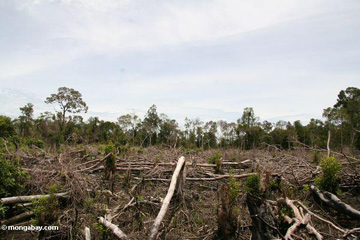Peatlands restoration is a cheap way to cut CO2 emissions
Peatlands restoration is a cheap way to cut CO2 emissions
mongabay.com
December 7, 2007
Rehabilitating damaged peatlands in Indonesia may be one of the most cost-effective ways to cut emissions of greenhouse gases, said an international NGO.
Wetlands International found that peatlands restoration activities such as blocking drainage canals by establishing dams and reforestation have an initial investment cost of around 15 eurocents ($0.22) for every ton of avoided CO2 emissions. By comparison, carbon credits are presently trading at more than 26 euro ($34) per ton on European exchanges.
“Our restoration projects in both Kalimantan and Sumatra, which included investments in awareness campaigns and providing alternative, sustainable livelihoods, resulted in average costs of 1 euro / ton avoided CO2 in many degraded, logged areas,” said Wetlands International in a statement. “Of course further investments will be needed over-time to maintain the achievements, but these will come with additional income generation for local people. Compared to the value of carbon credits or measures taken in Annex 1 countries to reduce CO2 emissions (several tens of euros per ton CO2); this is extremely cheap.”

|
The group says it has restored 60,000 hectares of peat swamp in Central Kalimantan, reducing annual emissions of more than 4 million tons of carbon dioxide per year. Wetlands International estimates that there are over one-and-a-half million hectares in Central Kalimantan and another 11.5 million hectares elsewhere in Indonesia that can be restored. Peatland restoration also reduces the risk of catastrophic peat fires, which can burn for months and release hundreds of millions of tons of CO2.
Wetlands is also reforesting degraded peatlands, resulting in additional carbon sequestration.
“In the Berbak National Park in Jambi, Sumatra, we carried out a similar project,” said Wetlands International. “By supporting community based activities aimed at fire prevention, stopping illegal logging, restoring the hydrology, reforestation and raising awareness, we were able to reduce the annual emissions with 55 tonnes CO2 per hectare, with a total of 2.4 million tonnes CO2 per year in an area of 43,000 ha.”
Overall, Wetlands calculates that peatlands degradation in Indonesia releases some 2 billion tons of carbon dioxide per year, helping make Indonesia the third largest producer of greenhouse gases.